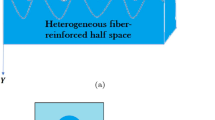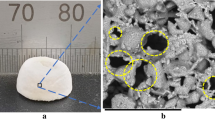Abstract
Model composite media − 10×15×80 mm3 bone tissue phantoms based on an epoxy resin with fillers—were made to study the influence of porosity and mineral content on ultrasound velocity and attenuation. The pores were simulated by ∼ 1 mm3 particles of a soft rubber, while the mineral content was imitated by a mineral residue of natural bone obtained by burning and grinding. The porosity and mineral content were varied in the range of 0–70% by volume with a step of 10%. The velocity, attenuation, and prevalent frequency of ultrasound were measured by the pulse transition method, using transducers with nominal frequencies 0.1, 0.2, 0.5, and 1.0 MHz. It was experimentally found that the ultrasound velocity decreased nearly exponentially with growth in porosity, while the velocity dispersion was negligible at frequencies >0.2 MHz; the ultrasound attenuation increased linearly with growth in porosity and strongly depended on the frequency; the velocity increased nonlinearly with growth in mineral content above 40%; the attenuation did not exhibit a distinct dependence on the mineral content; the porosity provoked a shift in the prevalent frequency of transducers, tending to the common value of 0.2 MHz, while the mineral content did not excite similar changes. The complex measurement of velocity, frequency-dependent attenvation, and prevenlent frequency of ultrasound is proposed in ultrasonic diagnostics of bone for more precise determination of the influence of the porosity and the degree of mineralization on the bone condition.
Similar content being viewed by others
References
W. Abendshein and G. W. Hyatt, “Ultrasonics and selected physical properties of bone,” Clinical Orthopaedics, No. 69, 294–301 (1970).
R. N. McCarthy, L. B. Jeffcott, and R. N. McCartney, “Ultrasound speed in equine cortical bone: effects of orientation, density, porosity, and temperature,” J. Biomech.,23, No. 11, 1139–1143 (1990).
A. J. Clarke, J. A. Evans, J. G. Truscott, R. Milner, and M. A. Smith, “A phantom for quantitative ultrasound of trabecular bone,” Phys. Med. Biol.,39, 1677–1687 (1994).
T. M. Cleek, B. C. Lentle, and D. L. Kendler, “The Vancouver calcaneal ultrasound phantom,” Osteoporosis Int.,7, No. 3, 295 (1997).
J. Tremple, R. Morris, and R. Nord, “Phantoms for Achilles ultrasonometry,” Osteoporosis Int.,7, No. 3, 297 (1997).
R. B. Martin, “Determinants of mechanical properties of bone,” J. Biomech.,24, Suppl. 1, 79–88 (1991).
L. V. Avioli and S. M. Krane (eds.), Metabolic Bone Disease and Clinically Related Disorders, 2nd ed., W. B. Saunders, Philadelphia (1990).
K. R. Piekarski, “Morphology and fracture of bone,” in: Fracture 1977, Proc. 4 Int. Conf. Fracture. Vol. 1, Waterloo, Canada (1977), pp. 607–642.
F. Melsen, B. Melsen, L. Mosekilde, and S. Bergmann, “Histomorphometric analysis of normal bone and iliac crest,” Acta Pathol. Microbiol. Scand.,86, 70–81 (1978).
S. A. Goss, R. L. Johnston, and F. Dunn, “Comprehensive compilation of empirical ultrasonic properties of mammalian tissues,” J. Acoust. Soc. Amer.,64, No. 2, 423–467 (1978).
M. B. Shaffler, and D. B. Burr, “Stiffness of compact bone: effects of porosity and density,” J. Biomech,21, 13–16 (1988).
J. D. Currey, “The effect of porosity and mineral content on the Young's modulus of elasticity of compact bone,” J. Biomech.,21, 131–139 (1988).
A. H. Burstein, J. M. Zika, K. G. Heiple, and L. Klein, “Contribution of collagen and mineral to the elastic-plastic properties of bone,” J. Bone Joint Surg.,57A, 956–961 (1975).
Author information
Authors and Affiliations
Additional information
Published in Mekhanika Kompozitnykh Materialov, Vol. 35, No. 2, pp. 211–220, March–April, 1999.
Rights and permissions
About this article
Cite this article
Tatarinov, A., Pontaga, I. & Vilks, U. Modeling the influence of mineral content and porosity on ultrasound parameters in bone by using synthetic phantoms. Mech Compos Mater 35, 147–154 (1999). https://doi.org/10.1007/BF02257245
Received:
Revised:
Issue Date:
DOI: https://doi.org/10.1007/BF02257245




